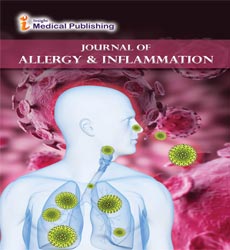Symptoms of Allergic Syndrome and its Treatment
Lucas Garcia
Lucas Garcia*
Department of Allergy, Research Institute, Madrid, Spain
- Corresponding Author:
- Lucas Garcia
Department of Allergy
Research Institute, Madrid, Spain
E-mail: lsgracia@unex.es
Received: October 16, 2021, Accepted: November 15, 2021, Published: November 22, 2021
Citation:Garcia L (2021) Symptoms of Allergic Syndrome and its Treatment. Arch Inflamm Vol.3 No.2:8
Oral allergy syndrome, also known as pollen food syndrome, is caused by cross-reactive allergens found in both pollen and raw fruits, vegetables, or some nuts. The immune system recognizes proteins similar to pollen grains in food and also initiates an allergic reaction to them. OAS is a type of contact allergic reaction that occurs when the mouth and throat come into contact with raw fruits and vegetables [1]. The most common symptoms of OAS include itching and swelling of the mouth, face, lips, tongue, and throat.
Nourishment sensitivities are resistant framework responses that happen in the blink of an eye after a specific nourishment is devoured. Indeed little sums of nourishments that cause hypersensitivities can cause signs and indications such as stomach related issues, hives, and swelling of the aviation routes. In such individuals, nourishment hypersensitivities can cause serious side effects and indeed a life-threatening response called anaphylaxis [2]. Food allergies affect an estimated 6-8% of children under the age of 3 and up to 3% of adults. There is no cure, but some children grow out of food allergies as they get older in their daily lives. It's easy to confuse food allergies with a common reaction known as food intolerance. Food intolerance, on the other hand, is a less serious condition that does not involve the immune system. For some people, an allergic reaction to a particular food can be unpleasant, but not serious. For others, allergic food reactions are also frightening and can even be life-threatening. Symptoms of food allergies usually develop within minutes to two hours of eating food.
The most common signs and symptoms of food allergies are itching and itching in the mouth, hives, itching and eczema, swelling of the lips, face, tongue, throat, or other parts of the body, wheezing, stuffy nose, and difficulty breathing. And so on, Abdominal pain, diarrhoea, or sick vomiting, dizziness, light headedness, or fainting.
Anaphylaxis: In some people, food allergies can cause a severe allergic reaction called anaphylaxis. This can cause lifethreatening signs and symptoms, such as narrowing or narrowing of the airways. Swelling of the throat, rugged dyspnoea, shock due to a sudden drop in blood pressure, rapid pulse, dizziness, light headedness, loss of consciousness. Anaphylaxis requires urgent treatment. If left untreated, anaphylaxis can lead to coma or death. When to talk to your doctor: If you have symptoms of food allergies immediately after eating, talk to your doctor or allergist. Therefore, if possible, see a doctor if you have an allergic reaction. This will offer assistance your specialist make a conclusion.
If you have a food allergy syndrome, the immune system unknowingly identifies certain foods or substances in foods as harmful. In response, the immune system triggers cells to release an antibody called immunoglobulin E, which neutralizes allergic foods and substances [3].
Therefore, the next time you eat a small amount of food, the IgE antibody senses it and signals the immune system to release chemical called histamine and other chemicals into the bloodstream. These chemicals cause allergic symptoms. In adults, most food allergies are caused by certain proteins: crustaceans such as shrimp, red shrimp and crabs, nuts such as walnuts and pecans, and fish. In children, food allergies are often caused by certain proteins such as peanuts, nuts, eggs, milk, wheat and soybeans. Before consuming allergic foods, talk to your child's doctor about the best time to serve them.
References
- Bock SA, Munoz Furlong A, Sampson HA (2001) Fatalities due to anaphylactic reactions to foods. J Clin Immunol 107: 191-193.
- McNeil MM, Weintraub ES, Duffy J, Sukumaran L, Jacobsen SJ et al. (2016) Risk of anaphylaxis after vaccination in children and adults. J Allergy Clin Immunol 137: 868-878.
- Burton DR, Poignard P, Stanfield RL, Wilson IA (2012) Broadly neutralizing antibodies present new prospects to counter highly antigenically diverse viruses. Sci 337: 183-186.
Open Access Journals
- Aquaculture & Veterinary Science
- Chemistry & Chemical Sciences
- Clinical Sciences
- Engineering
- General Science
- Genetics & Molecular Biology
- Health Care & Nursing
- Immunology & Microbiology
- Materials Science
- Mathematics & Physics
- Medical Sciences
- Neurology & Psychiatry
- Oncology & Cancer Science
- Pharmaceutical Sciences
